What other diseases are spread by black-legged ticks?
Black-legged ticks can transmit pathogens that cause other diseases in addition to, or instead of, Lyme disease. These diseases are called “other tick-borne diseases” or, when you get them along with Lyme disease, co-infections. Though not as common as Lyme disease, other tick-borne diseases are on the rise and can be serious, so it is important to be aware of them.
If you are bitten by a tick, make sure you ask your doctor about the possibility of other tick-borne diseases, not just Lyme disease. Tell your doctor about all your symptoms — they can provide clues about which tests you need, because Lyme disease tests only look for Lyme disease.

Getty Images
Other diseases spread by black-legged ticks may have some symptoms in common with Lyme disease and with one another. Treatment may also overlap: for example, several tick-borne diseases are treated with the same antibiotics as Lyme disease.
Other tick-borne diseases do not respond to the same medications and will not improve without appropriate treatment. Another difference is transmission time, which refers to how long a tick needs to be attached to you in order to transmit the disease-causing pathogen. Transmission time for tick-borne pathogens can range from minutes to days.
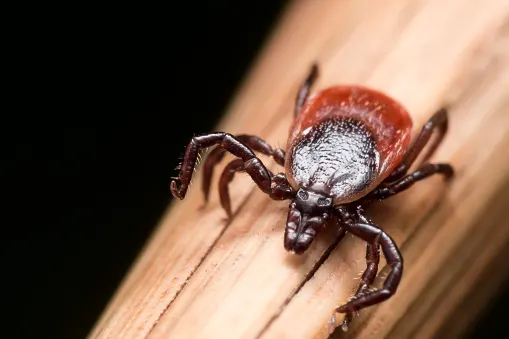
Getty Images
There are also many other types of ticks in the U.S. that spread other diseases. We’ll focus first on the diseases carried by black-legged ticks. Later in the section we’ll discuss other ticks found in the U.S., and diseases they can cause. It’s good to be aware of other ticks that you might encounter where you live or when you travel.
Black-legged ticks can spread the following diseases.
Anaplasmosis
What causes it?
The bacteria Anaplasma phagocytophilum
Where is it most common?
In the Northeast and mid-Atlantic U.S., from northeastern Virginia to Maine; in North Central states like Wisconsin and Minnesota; and on the West Coast, particularly in northern California.
How quickly can it be transmitted to humans from a black-legged tick?
In most cases, the tick must be attached to a person for at least 12 to 24 hours to transmit the bacteria that causes anaplasmosis.
What are common symptoms?
- fever
- chills
- shaking
- severe headache
- malaise (a general feeling of discomfort or feeling unwell)
- muscle pain
- nausea, vomiting, diarrhea, or loss of appetite
- cough.
- If not diagnosed and treated early, anaplasmosis can lead to serious illness and even death.
How long does it typically take for symptoms to appear?
Five to 14 days after a tick bite.
Is treatment the same as for Lyme disease?
Yes. Both are usually treated with an antibiotic called doxycycline.
Babesiosis
What causes it?
Babesia (various types, most typically Babesia microti), a parasite that infects the red blood cells.
Where is it most common?
Mostly in the Northeast and upper Midwest, especially in New England, New York, New Jersey, Wisconsin, and Minnesota.
How quickly can it be transmitted to humans from a black-legged tick?
In most cases, the tick must be attached to a person for at least 36 hours to transmit the parasite that causes babesiosis.
What are common symptoms?
Some people with babesiosis have no symptoms. Others may experience:
- fever
- chills
- sweats, particularly night sweats
- malaise (a general feeling of discomfort or feeling unwell)
- fatigue
- muscle and joint pains
- headache
- loss of appetite, nausea (less common: abdominal pain, vomiting)
- hemolytic anemia (a type of anemia where red blood cells are destroyed faster than the body can replace them; symptoms include tiredness, dizziness, weakness, dark urine, a yellowing of the skin and whites of the eyes, and a spleen or liver that is larger than normal).
Babesiosis can be serious and even fatal for people who do not have a spleen; older adults; those with weakened immune systems due to conditions like cancer or HIV; and those with other serious health conditions like liver or kidney disease.
How long does it typically take for symptoms to appear?
One to nine weeks or longer.
Is treatment the same as for Lyme disease?
No. Babesiosis is usually treated either with different antibiotics, or with a combination of an antibiotic and an anti-malarial medication.
Borrelia miyamotoi disease (Hard tick relapsing fever)
What causes it?
The bacteria Borrelia miyamotoi. This is a different species of the bacteria that causes Lyme disease.
Where is it most common?
The Upper Midwest, the Northeast, and the mid-Atlantic states.
How quickly can it be transmitted to humans from a black-legged tick?
A tick can transmit the bacteria that causes Borrelia miyamotoi disease within 24 hours of attaching to a person.
Borrelia miyamotoi disease can be transmitted by larval black-legged ticks, which are smaller and in an earlier life stage than the nymphal and adult black-legged ticks that typically spread the Lyme disease bacteria. As with other tick-borne diseases, you may develop symptoms of Borrelia miyamotoi disease without ever noticing a tick or tick bite.
What are common symptoms?
- fever
- chills
- headache
- body and joint pain
- fatigue
How long does it typically take for symptoms to appear?
Days to weeks after a tick bite.
Is treatment the same as for Lyme disease?
Borrelia miyamotoi disease can be treated with the same antibiotic, doxycycline, used to treat Lyme disease, though you may need to take it for a longer amount of time. It is also sometimes treated with other antibiotics.
Ehrlichiosis
What causes it?
The bacteria Ehrlichia muris eauclairensis. (Ehrlichiosis transmitted by the lone star tick is discussed in Other types of ticks and the diseases they spread, below).
Where is it most common?
The Upper Midwest.
How quickly can it be transmitted to humans from a black-legged tick?
In most cases, a tick must be attached to a person for about 24 hours to transmit the bacteria that cause ehrlichiosis.
What are common symptoms?
- fever
- chills
- headache
- malaise (a general feeling of discomfort or feeling unwell)
- muscle pain
- nausea, vomiting, diarrhea, or loss of appetite
- confusion
- rash (more common in children)
How long does it typically take for symptoms to appear?
One to two weeks after a tick bite.
Is treatment the same as for Lyme disease?
Yes. Both are usually treated with an antibiotic called doxycycline. The length of treatment may be different for ehrlichiosis and Lyme disease.
Powassan virus disease
What causes it?
The Powassan virus.
Where is it most common?
In the Northeast and Great Lakes regions, particularly Massachusetts, New York, Minnesota, and Wisconsin. (See Other types of ticks and the diseases they spread for information about Powassan virus spread by other ticks in the U.S.).
How quickly can it be transmitted to humans from a black-legged tick?
A tick can transmit the virus that causes Powassan virus disease within 15 minutes of attaching to a person.
What are common symptoms?
Many people with Powassan virus don’t experience symptoms, but early symptoms can include
- fever
- headache
- vomiting
- weakness
Powassan virus can become severe, causing encephalitis (infection of the brain) or meningitis (swelling of the membranes that surround the brain and spinal cord). In some cases, Powassan virus disease can be fatal.
How long does it typically take for symptoms to appear?
One to two weeks after a tick bite.
Is treatment the same as for Lyme disease?
There is currently no treatment for Powassan virus. People with severe Powassan virus are often hospitalized for symptom management.
Other types of ticks and the diseases they spread
Different types of ticks are found in various parts of the U.S. All of these ticks look a little different and can spread pathogens that cause different diseases.
Tell your doctor if you are bitten by any type of tick. If you can, take a photo of the tick, to help you and your doctor determine what kind of tick it is.
The following table can help you identify different types of ticks and the diseases they can spread. If you are bitten by a tick, ask your doctor if you should be tested for diseases the tick could have been carrying, and what symptoms you should watch for.
| Tick Name | Image (photo credit: CDC) | Location(s) Found | Disease(s) Carried |
|---|---|---|---|
| American Dog Tick (Dermacentor variabilis and D. Similis) | D. variabilis is widespread east of the Rockies. The newly described D. Similis is in clusters on the Pacific coast. | Rocky Mountain spotted fever, tularemia | |
| Brown dog tick (Rhipicephalus sanguineus) | 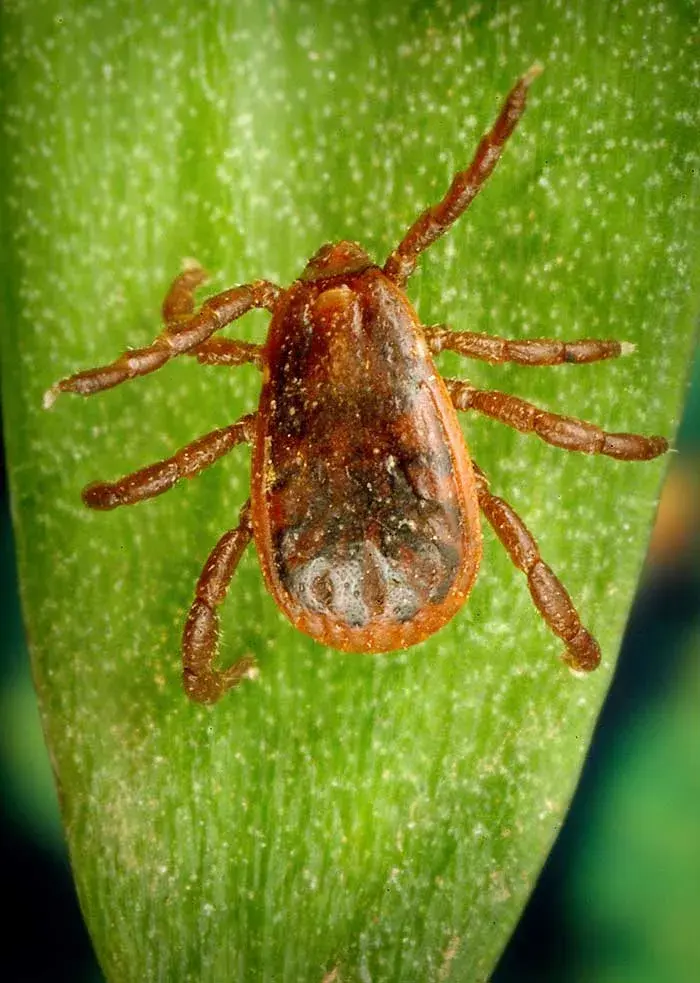 | Throughout the U.S | Rocky Mountain spotted fever (mostly in the southwestern United States and along the U.S.-Mexico border) |
| Groundhog tick or woodchuck tick (Ixodes cookei) | 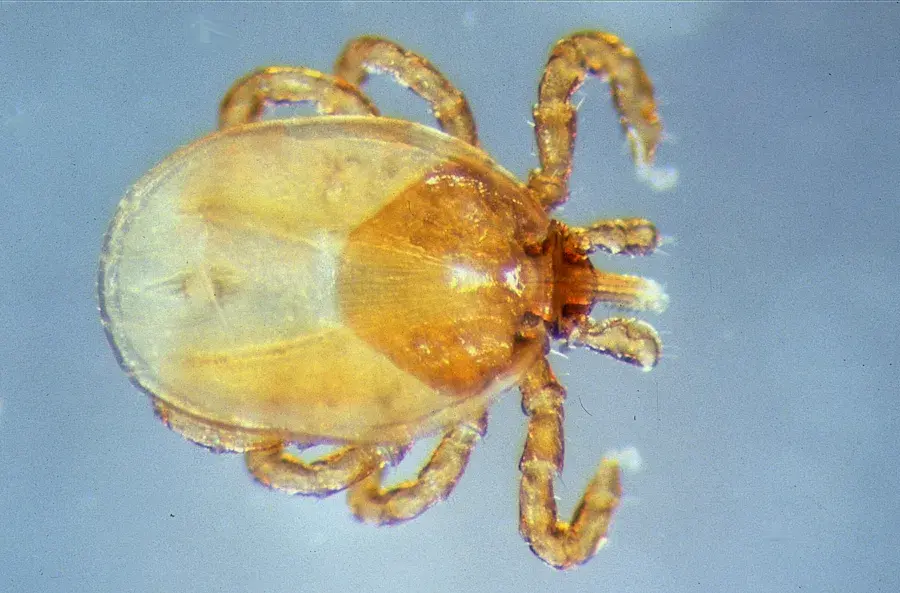 | Throughout the eastern half of the United States | Powassan virus disease |
| Gulf Coast tick (Amblyomma maculatum) | 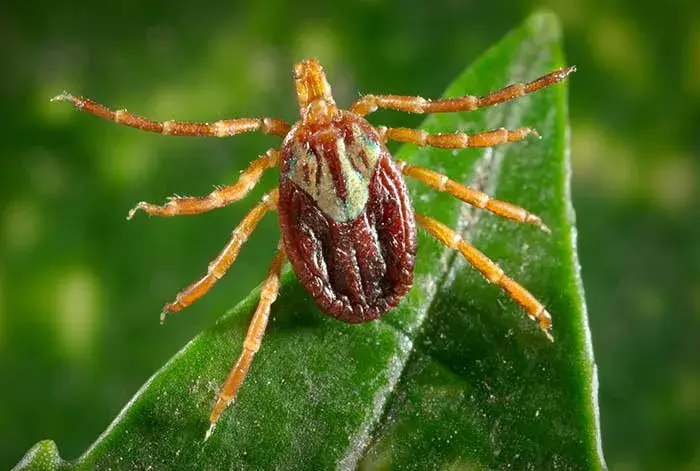 | Southeastern and mid-Atlantic states; Arizona | R. parkeri rickettsiosis, a form of spotted fever |
| Lone star tick (Amblyomma americanum) | 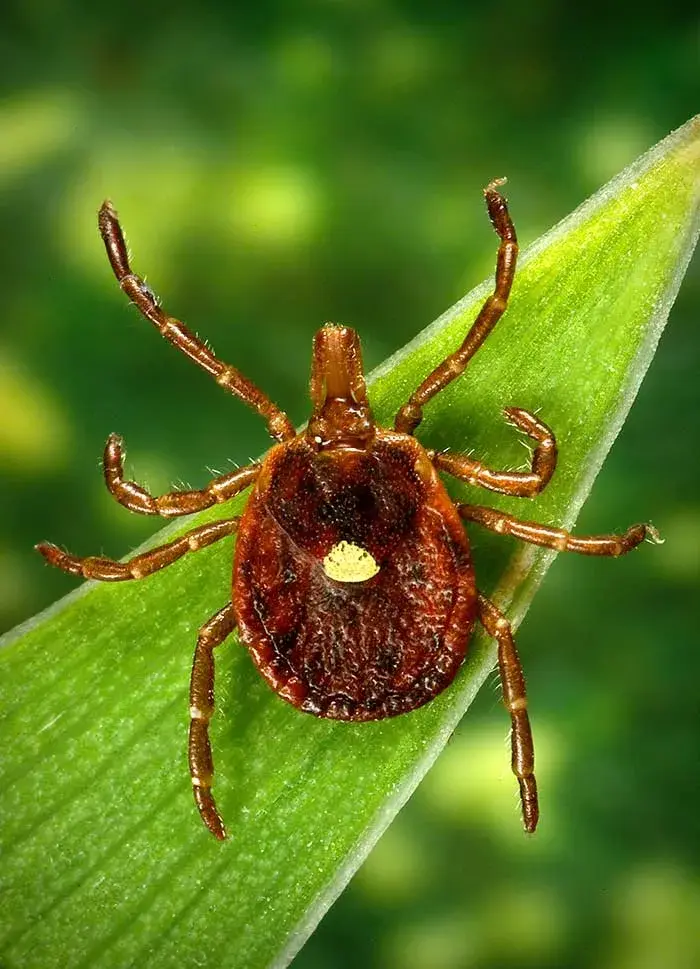 | Most common in the South, also found throughout the eastern U.S. | Alpha-gal syndrome (red meat allergy), Bourbon virus disease, ehrlichiosis, heartland virus disease, tularemia, Southern tick-associated rash illness (STARI) |
| Rocky Mountain wood tick (Dermacentor andersoni) | 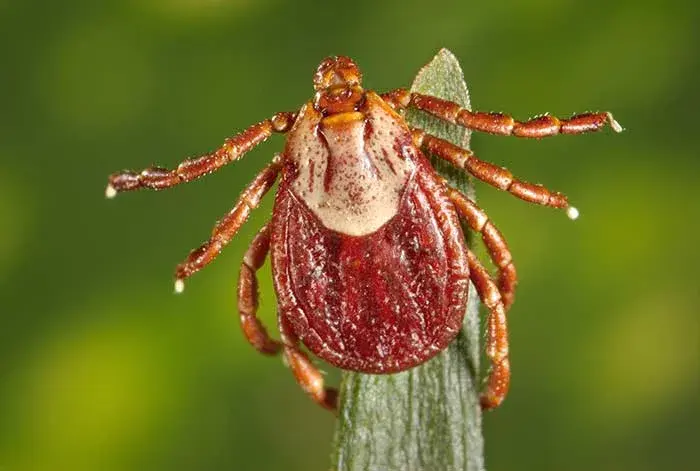 | Rocky Mountain states | Rocky Mountain spotted fever, tularemia |
| Soft tick (Ornithodoros, multiple species) | 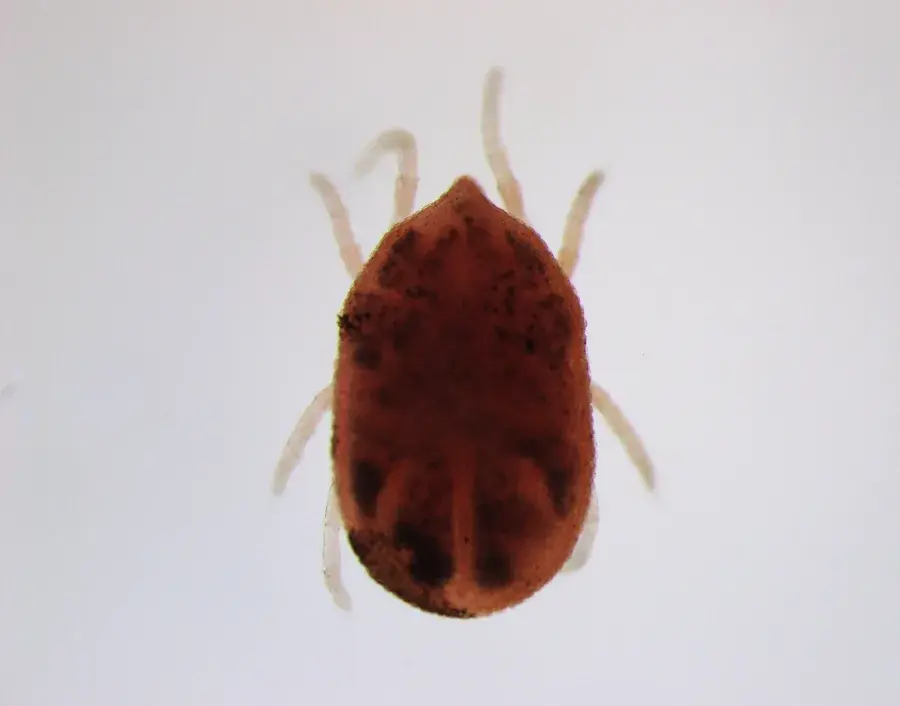 | Throughout the western half of the United States, including Texas | Tick-borne relapsing fever |
Tick-borne illness outside the United States

Different types of ticks in other parts of the world can carry different strains of Lyme disease bacteria, or other infections. Tell your doctor about all previous travel, especially if your symptoms began during or after that travel. For travelers to Europe and Asia, there is a very low risk of tick-borne encephalitis. This is the only tick-borne disease for which a vaccine is available. If you are traveling to Europe or Asia, talk to your doctor about whether your location or activities might put you at risk for tick-borne encephalitis, and if you should get vaccinated.
1. About Borrelia miyamotoi disease. Minnesota Department of Health website.
https://www.health.state.mn.us/diseases/bmiyamotoi/basics.html
2. Alpha-gal and red meat allergy. American Academy of Allergy, Asthma, and Immunology website, April 2019.
https://www.aaaai.org/tools-for-the-public/conditions-library/allergies/alpha-gal-and-red-meat-allergy
3. Anaplasmosis. Boston Public Health Commission website.
https://www.bphc.org/whatwedo/infectious-diseases/Infectious-Diseases-A-to-Z/Pages/Anaplasmosis.aspx
4. Anaplasmosis. CDC website, October 2020.
https://www.cdc.gov/ticks/tickbornediseases/anaplasmosis.html
5. Borrelia miyamotoi disease. CDC website, January 2019.
https://www.cdc.gov/ticks/tickbornediseases/borrelia-miyamotoi.html
6. Ehrlichiosis. CDC website, October 2020.
https://www.cdc.gov/ticks/tickbornediseases/ehrlichiosis.html
7. Identification guide. TickEncounter: The University of Rhode Island website.
https://web.uri.edu/tickencounter/fieldguide/id-guide/
8. Lifecycle of blacklegged ticks. CDC website, April 2011.
https://www.cdc.gov/lyme/transmission/blacklegged.html
9. Lyme disease frequently asked questions. CDC website, January 2021.
https://www.cdc.gov/lyme/faq/index.html
10. Lyme: The First Epidemic of Climate Change by Mary Beth Pfeiffer. Island Press, April 2018.
https://www.thefirstepidemic.com/
11. Parasites – Babesiosis. CDC website, April 2018.
https://www.cdc.gov/parasites/babesiosis/gen_info/index.html
12. Pathogen transmission in relation to duration of attachment by Ixodes scapularis ticks. Ticks and Tick-Borne Diseases, 2018.
https://pubmed.ncbi.nlm.nih.gov/29398603/
13. Powassan virus. CDC website, July 2021.
https://www.cdc.gov/powassan/index.html
14. Powassan virus. National Library of Medicine, August 2021.
https://www.ncbi.nlm.nih.gov/books/NBK570599/
15. Powassan virus disease fact sheet. New York State Department of Health website, July 2017.
https://www.health.ny.gov/diseases/communicable/powassan/fact_sheet.htm
16. Tick ID. CDC website, January 2019.
https://www.cdc.gov/ticks/tickbornediseases/tickID.html
17. Tick-borne diseases of the United States: a reference manual for health care providers. Fifth edition. CDC Stacks, 2018.
https://stacks.cdc.gov/view/cdc/55837
18. Tick-borne diseases of the United States: Tick ID. CDC website, January 2019
https://www.cdc.gov/ticks/tickbornediseases/tickID.html
19. Tick-borne relapsing fever: B. miyamotoi. CDC website, September 2019.
https://www.cdc.gov/relapsing-fever/miyamotoi/index.html
20. Transmission of the relapsing fever spirochete, Borrelia miyamotoi, by single transovarially-infected larval Ixodes scapularis ticks. Ticks and Tick-borne Diseases, 2018.
https://pubmed.ncbi.nlm.nih.gov/30007502/
